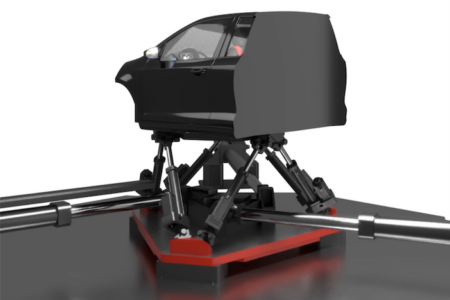Two companies are collaborating to develop what they describe as a “ground-breaking, all-electric automotive driving simulator.” The partners – MTS Systems Corporation, a supplier of test systems and sensors, and McLaren Applied Technologies, experts in high-performance design and technology – are developing the Vehicle Dynamics Simulator (VDS), which is intended to be used by vehicle manufacturers and their suppliers to conduct real-world driving simulations of vehicle performance.
The VDS is also intended to provide engineers with more insights earlier in the design cycle. These early insights can help engineers reduce new product introduction time and cost of development, and help improve the driving experience. The VDS will also be a vital tool in the development of ADAS (Advanced Driver Assistance Systems).
The VDS employs a “driver-in-the-loop” approach, allowing a driver to participate directly in the test so engineers can gather subjective (human) evaluations of components, systems and full-vehicles before prototypes are available. By coupling human input with the simulation results, new product designs can be evaluated and issues resolved early in the development process. The VDS is designed to allow engineers to evaluate everything from improvements in suspension and steering systems, to integrating the software and sensors needed to bring ADAS active safety systems, such as active braking and lane assistance, into the mainstream.
The fully operational system installed at the McLaren Technology Centre in Woking, UK, provides prospective customers with a state-of-the-art simulation experience that is made possible through proprietary technologies from both MTS and McLaren. McLaren Applied Technologies’ motion-cueing algorithms translate driver input into simulator commands that help create the illusion of vehicle motion. MTS’s system controls reproduce the motion commands with high fidelity and minimum latency, allowing objective data to be gathered and evaluated. The simulator also incorporates MTS’ mechanical Hardware-in-the-Loop (mHIL) Technology, which allows a physical automotive component or subsystem to be tested as part of the simulation environment.
“With the rapid rise in automotive technology, the industry is increasingly relying upon simulation, in conjunction with laboratory testing, as an alternative to its historical dependence upon test tracks to bring new products to market. This approach allows test engineers to cover more design iterations in a shorter period of time,” explained Dr Jeffrey Graves, MTS president and CEO. “Responding to that trend, VDS makes use of McLaren’s longstanding leadership in F1 racing and the experience that its engineering team has gained in dealing with challenges on the racetrack, alongside our own state-of-the-art automobile test technologies.”
“This highly sophisticated unit provides a real value proposition to all the organizations participating in different stages of vehicle development,” added Dick Glover, CTO of McLaren Applied Technologies. “It will prove highly advantageous not only to the smaller companies who have limited capital to invest in the hardware needed for real world tests, but also the larger established companies as they can get test procedures completed in a much shorter timeframe.”




